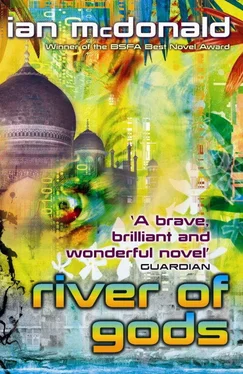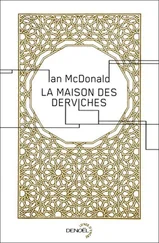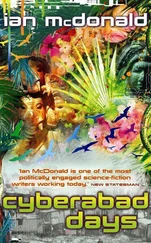“I have to tell you, this liberal arts boy doesn’t understand a word of this.”
“No one does. Not deep down; understand as we understand understanding. All we have is a description of how it works, and it works better than any theory we’ve ever come up with, and that’s including M-Star theory. It’s like the mind of Brahma; no one can understand the thoughts of a creator deity, but that doesn’t mean that there is no creation.”
“For a scientist, you use a lot of religious metaphors.”
“This scientist believes we live in a Hindu universe.” Sonia Yadav presses her point. “Don’t get me wrong, I’m not like those Christian fundamentalist creation scientists—that’s not science; it denies empiricism and the very fact the universe is knowable. Creationists adapt the empirical evidence to suit their particular scriptural interpretation. I think what I think because of the empirical evidence. I’m a rational Hindu. I’m not saying I believe in actual gods, but quantum information theory and M-Star theory teach you the connectedness of all things and how properties emerge that can never be predicted by any of the constituent elements and that the very large and the very small are two sides of the same superstring. Do I need to tell a Ray about Hindu philosophy?”
“Maybe this Ray. So you’ll not be pulling N. K. Jivanjee on his rath yatra.” He’d seen the photographs on the evening news. Hell of a scoop.
“I’ll not be pulling, but I might be in the crowd. And anyway, it’s got a biodiesel engine in it.”
Vishram sits back in his chair, pulls at his lower lip as he does when observations and turns of phrase come flocking and cawing into a comedy routine.
“So tell me; you haven’t got a bindi and you’re out without a chaperone; how does this all sit with N. K. Jivanjee and the mind of Brahma?”
Sonia Yadav does the pucker again.
“I will say this straight and simple. Jati and varna have benighted our nation for three thousand years. Caste was never a Dravidian concept—it was those Aryans and their obsession with division and power. That’s why the British loved it here—they’re still fascinated with anything to do with this country. The class divide is their national narrative.”
“Not the bit of Britain I was in,” Vishram asides.
“For me, N. K. Jivanjee is about national pride, about Bharat for Bharat, not sold by the kilo to the Americans. About Hindu zero-point energy. And in the twenty first century, no woman needs a chaperone; and anyway, my husband trusts me.”
“Ah,” Vishram says, hoping his crestfallenness doesn’t carry. “So, M-Star theory?”
As far as he can get it, it’s like this. First there was string theory, which Vishram has heard of, something to do with everything being notes from vibrating strings. Very pretty. Very musical. Very Hindu. Then there was M-theory, which attempted to resolve the contradictions of string theory but which reached in different directions, like the legs of a starfish. The theoretical centre arrived last, in the late twenties in the shape of M-Star theory.
“I can see the star, but what’s the M for?”
“That’s a mystery,” Sonia Yadav smiles. They’re on Stregas now. The liqueur holds up well against the climate.
In M-Star theory the wrappings and foldings of the primal strings in eleven dimensions into membranes create the polyverse of all possible universes, all with fundamental properties differing from those experienced by humans.
“Everything is there,” says Sonia Yadav. “Universes with an extra time dimension, two-dimensional universes—there’s no gravity in two-dimensional universes. Universes where self-organisation and life is a basic property of space-time. An infinite number of universes. And that’s the difference between cold and hot zero-point theory.”
Vishram calls for another round of Stregas. He doesn’t know if it’s the Sip that Charms or the physics, but his brain is at the Swaddled in Cottonwool stage.
“What stops cold zero-point theory in its tracks is the second law of thermodynamics.” The waiter serves the second round. Vishram studies Sonia Yadav through the gold in the little bubble glass. “Stop that, and pay attention! To be useful, energy has to go somewhere. It’s got to flow from higher to lower, hot to cold, if you like. But in our universe the zero point, the quantum fluctuation, is the ground state. There’s nowhere for the energy to flow; it’s all uphill. But in another universe.”
“The ground state, whatever you call it, might be higher.” Sonia Yadav claps her hands together in a silent namaste.
“Exactly! Exactly! It would naturally flow from higher to lower. We could tap that infinite energy.”
“First find your universe.”
“Oh, we found one a long time ago. It’s a simple manifold of the M-Star theoretical structure of our own universe. Gravity is more powerful there; so is the expansion constant, so there’s a lot more vacuum energy tied up in the stressed space-time. It’s quite a small universe, and not too far away.”
“I thought you said the universes were all inside and outside each other.”
“They are, topologically. I’m talking about energy distance, how much we need to warp our ’branes to the geometry of that one. In physics, ultimately, everything is energy.”
Warped brains, all right.
Sonia Yadav sets her empty glass firmly on the gingham tablecloth, leans forwards, and Vishram cannot refuse the physical energy in her eyes, her face, her body.
“Come with me,” she says. “Come and see it.”
After Glasgow, the University of Bharat Varanasi at night is unusually well mannered. No discarded polystyrene trays of rain-soaked chips or dropped beer glasses or vomit pizzas to dodge in the brownout. No sounds of coitus from the halls or urination from the shrubberies. No sinister drunk reeling out of the peripheral vision with a racial curse. No gangs of half-naked girls arm in arm streeling across the dusty, withered lawns. What there is is a lot of heavy security, a few dons on big clunky bicycles with no lights, the rattle of a solitary night-radio and a sense from the shut-up faculty buildings and student residences of curfew.
The driver heads towards the only light. The experimental physics building is an orchidlike confection of luminous plastic sheeting and pylons, daring and delicate. The name on the marble plinth is the Ranjit Ray Centre for High Energy Physics. Buried beneath the delicate, flowery architecture is a grunt engineering pulse laser particle collider.
“He seems to have been a man of many parts, my father,” Vishram says as the night security nods them through the lobby. His face is known now.
“He’s not dead,” Sonia Yadav says and Vishram starts.
An elevator bank at the end of the lobby takes them down a tube to the root of the beast. It is a mythological creature indeed, a world-devouring worm curled in a loop beneath Sarnarh and Ganga. Vishram looks through the glass observation window at electrical devices each the size of a ship engine and tries to imagine particles forced into strange and unnatural liaisons.
“When we run it to full power to open an aperture, those containment magnets put out a field strong enough to suck the haemoglobin out of your blood,” Sonia Yadav says.
“How do you know this?” Vishram asks.
“We tried it with a goat, if you really want to know. Come on.”
Sonia Yadav leads the way down a long flight of concrete steps to an air-lock door. The security panel eyeballs her, opens into an airlock.
“Are we going into space or something?” Vishram asks as the lock cycles. “It’s just a containment device.”
Vishram decides he doesn’t want to know what’s being contained, so he fluffs, “I know my father’s rich—was rich—and there’s rich buys private jets, rich buys private islands, but rich that buys private particle colliders.”
Читать дальше












